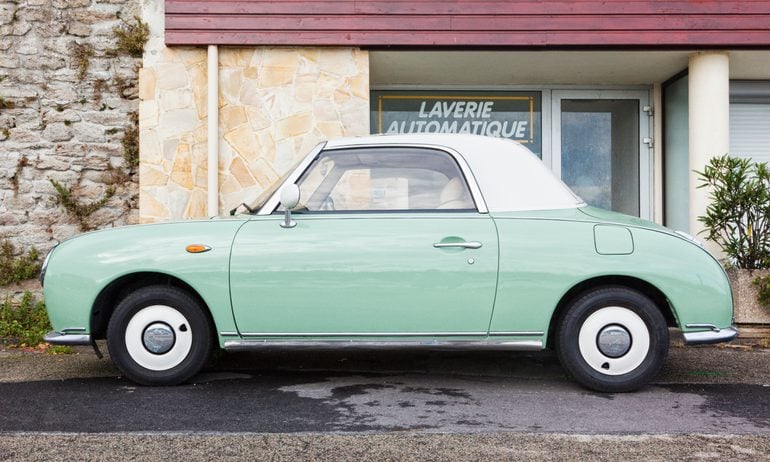How to Buy a Cool, Cheap Imported JDM Car
Tiny '90s-era Japanese imports are having a moment. Here's what you need to know.

Many, or all, of the products featured on this page are from our advertising partners who compensate us when you take certain actions on our website or click to take an action on their website. However, this does not influence our evaluations. Our opinions are our own. Here is a list of our partners and here's how we make money.
If you drive your cute, imported Nissan Figaro to a cars-and-coffee meetup, you’ll be mobbed with fans. Meanwhile, the rich guy across from you is all alone with his Ferrari because everyone’s already seen that car.
At least that’s what importer Gary Duncan says after selling these unique foreign cars, many of them from Japan, for decades at his dealerships in Virginia and Tennessee.
“It’s the aesthetics” that draws people to these cars, says Jim Simpson, a car designer and collector who has owned and restored dozens of Japanese cars and has an early 1990s Toyota Sera as a daily driver. “For not a lot of money, you can get a car that you don’t see on every street corner,” he says.
Unlike German, English or Italian collectibles, Japanese imported cars are more reliable, easier to maintain and sometimes use parts that are interchangeable with available U.S. models, says Simpson. To top that off, you can have fun driving one for a few years and perhaps even sell it at a profit.
Explore the auto-buying platforms from our partners below.
AD
The 25-year rule
Once a car is 25 years old, it can be imported without meeting U.S. safety and emissions standards (some states have additional restrictions). This opens up a niche market for budget-minded collectors.
But before you buy a Nissan Figaro or the adorable Honda Beat sports car, or the Suzuki Carry Mini-Truck, you need to know that they are small — some are tiny — have the steering wheel on the right side and often lack the features we’ve become used to, such as air conditioning.
It requires some practice to drive a right-hand-drive car on American roads, but you quickly get used to it, says Simpson. Since most of these cars are from the early '90s, they come with a manual transmission, which means you also have to shift with your left hand.
Mostly these are fun second cars. While many are inexpensive, they are not easy to insure or finance, and their age and size mean compromises on safety and comfort.
The lure of ‘JDM’ cars
A popular niche for imported cars is the Japanese Domestic Market, or JDM for short. In Japan, older cars are subjected to increasingly restrictive testing that effectively encourages owners to sell them. Since many of these cars are still in good condition and have low miles, they attract American enthusiasts and collectors.
JDM fans run the gamut from Gran Turismo enthusiasts, anime fans (because the drawings often feature JDM cars), Japanese street racing fans and drivers looking for “exclusivity,” says Steve Ellis, sales associate at Toprank International Vehicle Importers in Cypress, California.
While prices for the ultra-popular Nissan Skyline, which was never sold in the U.S., were in the $30,000 range on Duncan Imports, a buyer aiming to spend $15,000 or less could choose from an array of vans, trucks and sports cars, even big sedans like the limousine-like Toyota Century.
Even smaller Kei cars
A popular subset of the Japanese market is the “Kei car,” a vehicle class established after World War II to get the Japanese auto industry back on its feet. Kei cars have size limits, and the engines are restricted to a mere 64 horsepower.
While not very practical, Motor Trend says there is “a massive amount of diversity, innovation, and outright fun in the class.” Duncan says the Kei car work trucks, such as the Suzuki Carry, are especially hot right now since they fill a need not met by modern domestic vehicles.
Still, these little cars pack a lot of fun for driving enthusiasts. Many of them are rear-wheel-drive, which provides better handling, and their tiny engines respond eagerly. “My [Toyota] Sera is a delight to drive,” says Simpson.
Buying an imported car
If an imported or JDM car appeals to you, Simpson recommends shopping through a dealer that knows how to work with international shipping companies and customs officials. Here are a few other considerations:
Before you buy the car, look in your area for a mechanic who specializes in service and repair for the brand you want.
Check to see if parts are available for the car you’re considering.
If you’re buying the car sight unseen, have it inspected by a local mechanic.
JDM cars don’t have vehicle identification numbers, or VINs, which makes it harder to track their history. Instead, ask for the car’s “auction sheet,” which should list aftermarket modifications, repainting and any accidents or body damage.
Financing and insurance
There are a small number of insurance companies that specialize in classic and imported cars, such as Hagerty. Financing is a bit more difficult.
Unlike buying from traditional auto dealers, who can easily arrange financing, buying an imported car might require using a harder-to-get personal loan. Here are a few things to consider when shopping for and applying for a personal loan:
The interest rate could be higher than a typical auto loan because an imported car isn’t easily valued as collateral. You’ll get the loan on the strength of your credit and debt picture.
Some lenders may want to know the reason for the loan when deciding your rate.
Try to pre-qualify for a loan so you can see what kind of rates you’re offered.
If the interest rates you’re offered seem too high, you can save for the car and pay cash.









